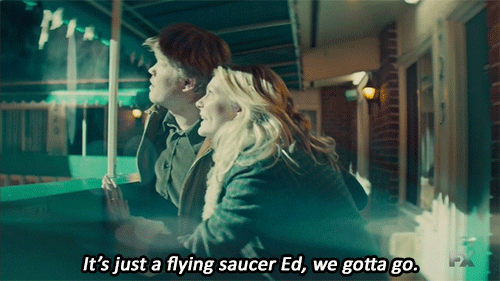Deus Ex Machina
O universo de Fargo está de fato cheio de ocorrências de Deux Ex Machina (inexplicável sorte). Por exemplo, Lorne Malvo desaparecendo do porão de Lester ou Stavros encontrando o dinheiro na primeira temporada, ou na terceira temporada:
Então o OVNI nesta cena é provavelmente outra ocorrência que permite que Ed e sua esposa escapem.
OVNIs em Fargo
Agora, sobre OVNIs, você pode lembrar que esta não é a primeira vez que os OVNIs são mencionados em Fargo. Não vou estragar, mas você encontrará muitas referências, já que era uma tendência comum na época da segunda temporada.
Explicação de Nah Hawley
Sobre essa cena, Noah Hawley respondeu :
“What was the deal with the UFOs?”
At first, Hawley tried to brush off the question. “What was the deal with the UFOs? What was the deal with the fish falling from the sky in the first year? I mean, these things happen.”
“Yeah, but you explained [the fish],” Willimon said. “Granted, it was a tornado that hit a lake, but there was an explanation.”
“Well, it was part of the moment,” Hawley continued. “Post-Vietnam, it was that both the political paranoia and the conspiracy theories went all the way to the top — with Watergate; that sense that people were feeling paranoid on some level.”“If you look at the internet research device, there was a state trooper/UFO incident in Minnesota in the ’70s, which I thought was interesting,” Hawley added. “And then also Joel and Ethan [Coen] had included some of those visuals in ‘The Man Who Wasn’t There.’ There was definitely a UFO runner in there.”
But the truly interesting take came straight from the Coens’ original film.
“Very early on, I asked, ‘What is our Mike Yanagita?'” Hawley said. “Mike Yanagita was the character in the movie ‘Fargo’ who Marge met after being friends in high school and they had a meal, and he talked about marrying his high school sweetheart and then she died and he was so lonely. But then, later, you found out he made all that up. And I thought, ‘Why is this in the movie?’ It has nothing to do with the movie — except the movie says, ‘This is a true story.’ They put it in there because it ‘happened.’ Otherwise you wouldn’t put it in there. The world of ‘Fargo’ needs those elements; those random, odd, truth-is-stranger-than-fiction elements.”
“Especially because the storytelling is so compact, so tight, that it can’t be too tidy,” Willimon chimed in. “You have to add some untidiness to it.”
“Whenever you introduce those elements, you engage the audience’s imagination,” Hawley said. “When you’re not spoon-feeding a linear story, when you’re leaving gaps for the imagination, the audience is going to have to invest more in it. And I think that dynamic relationship is much better than just watching.”
